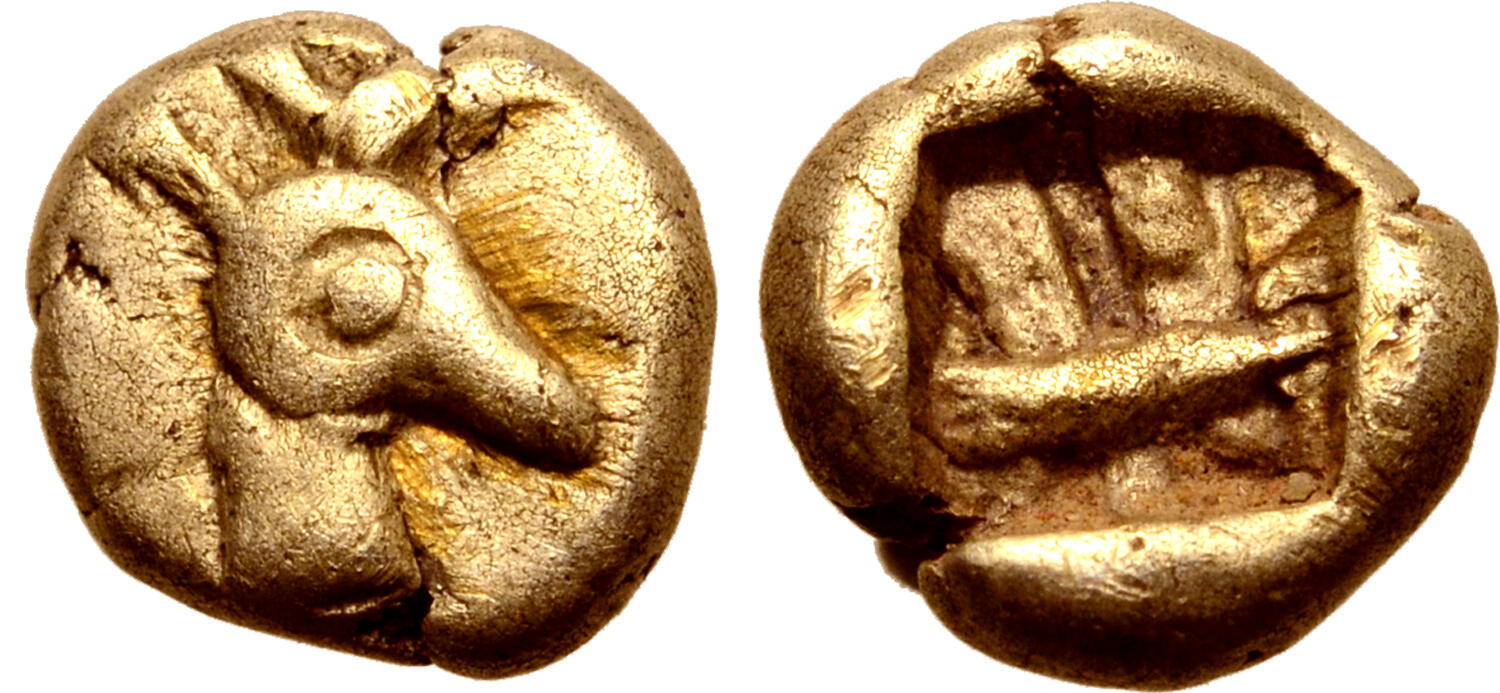S 1608 - Ephesus (Phanes), electrum, 1/48 staters (625-600 BCE)
From SILVER
625 BCE - 620 BC Electrum 438 kg
Description
| ObverseInscription or printing placed on the obverse.: | Head of stag to right |
| ReverseInscription or printing placed on the reverse.: | Abstract geometric pattern within incuse square |
Mint and issuing power
| MintIdentifies the place of manufacture or issue of a numismatic object.: | Ephesus | Ancient regionAncient region.: | Ionia | Modern countryModern country: Turkey | AuthorityIdentifies the issuing power. The authority can be "pretended" when the name or the portrait of X is on the coin but he/she was not the issuing power. It can also be "uncertain" when there is no mention of X on the coin but he/she was the issuing power according to the historical sources: |
Chronology
| FromIdentifies the initial date in a range assigned in a numismatic context. | 625 BCE | toIdentifies the final date in a range assigned in a numismatic context.. | 620 BC | PeriodTime period of the numismatic object.: Archaic until 480 BC |
Physical description
| MetalThe physical material (usually metal) from which an object is made.: | Electrum http://nomisma.org/id/el | Median weightMedian of the weights of numismatic objects (in grams). in grams | 0.28 | DenominationTerm indicating the value of a numismatic object. Examples: tetradrachm, chalkous, denarius.: | 1/48th stater | StandardStandard.: | Milesian |
Image

S1608 Phanes 48ths.jpg [1]
References
| Die study referencePublication of the study: | Fischer-Bossert 2020c1Fischer-Bossert 2020c, p. 454-455, n° 47-54 | ||
| Coin series referenceReference to coin series study: | |||
Obverse dies distribution
| FrequencyFrequency of specimen in distribution. ᵖ | Number of obversesNumber of obverse dies. ᵖ (o) | % (o) | Number of coinsNumber of coins. (n) | % (n) | Die nameName(s) of the die(s). |
| 1 | 1 | 14.29 | 1 | 2.94 | 28 |
| 2 | 1 | 14.29 | 2 | 5.88 | 31 |
| 3 | 2 | 28.57 | 6 | 17.65 | 29, 34 |
| 5 | 1 | 14.29 | 5 | 14.71 | 30 |
| 9 | 1 | 14.29 | 9 | 26.47 | 32 |
| 11 | 1 | 14.29 | 11 | 32.35 | 33 |
| Total | 7 of 7 | 100.02 | 34 of 34 | 100 |
Reverse dies distribution
no distribution is available
Quantification
| Number of obversesNumber of obverse dies. ᵖ (o) | 7 | Number of singletons (o1)The number of singleton coins. ᵖ | 1 |
| Number of reverse diesNumber of reverse dies. (r) | 6 | Number of coinsNumber of coins. (n) | 34 |
| Coins per obverse dieNumber of coins per obverse die. (n/o) | 4.86 | Coins per reverse dieNumber of coins per reverse die. (n/r) | 5.67 |
| Reverse per obverse ratioRatio of obverse dies divided by reverse dies. (r/o) | 0.86 | Percentage of singletons (o1)number of coins (n) divided by the number of singletons (o1) ᵖ | 14.29 % |
| Original number of dies (O) (Carter 1983 formula)The estimation of the number of coins according to Carter 1983 ᵖ | 7.82 | Coins struck if 20,000 as average productivity per dieCoins made if the average productivity for obverses (according to Carter) is 20,000. ᵖ | 156,400 |
| Original number of dies (O) (Esty 2011 formula)The estimation of the number of coins according to the singleton formula in Esty 2011 ᵖ (O) | 8.81 | Survival rate if 20,000 as average productivity per dieSurvival rate if average productivity is 20,000. ᵖ | 0.00022 |
| Coverage (o = % of O) (Esty 1984 formula)Esty 1984 - coverage (% of O) ᵖ (o = % of O) | 97.06% | Die productivity if survival rate 1/2,000Average productivity if survival rate is 1/2,000. ᵖ | 8,695.65 |
| Weight of silver (in kg) if 20,000 coins per die (O = Carter formula)Carter 1983 * Median weight * 20000 (*10 if gold or electrum) ᵖ | 438 kg <br /> 438 kg | Die productivity if survival rate 1/5,000Average productivity if survival rate is 1/5,000. ᵖ | 21,739.13 |
Remarks
References
- ^ Fischer-Bossert, Wolfgang (2020), "Phanes: a Die Study", in P. van Alfen, U. Wartenberg, W. Fischer-Bossert, H. Gitler, K. Konuk and C. Lorber (eds), White Gold. Studies in Early Electrum Coinage, New York/Jerusalem, p. 423-476.